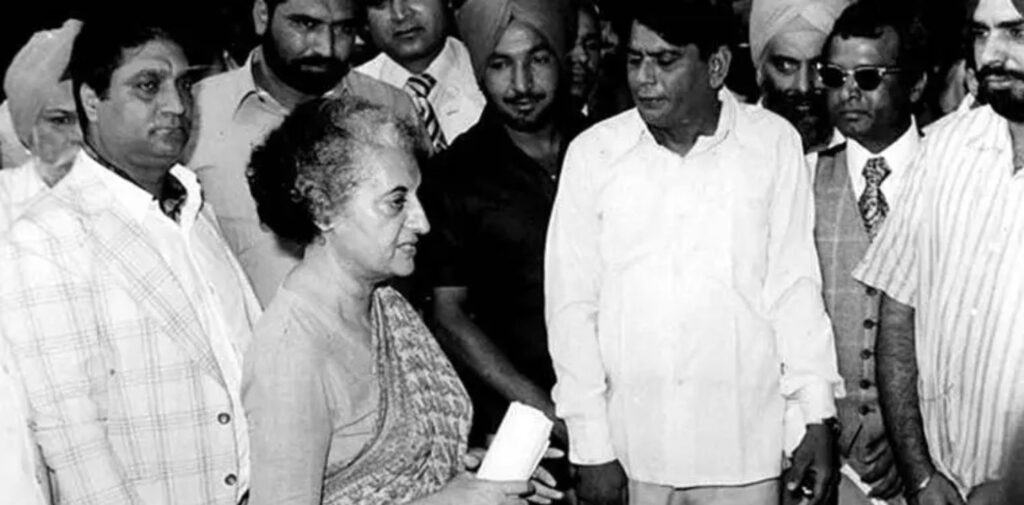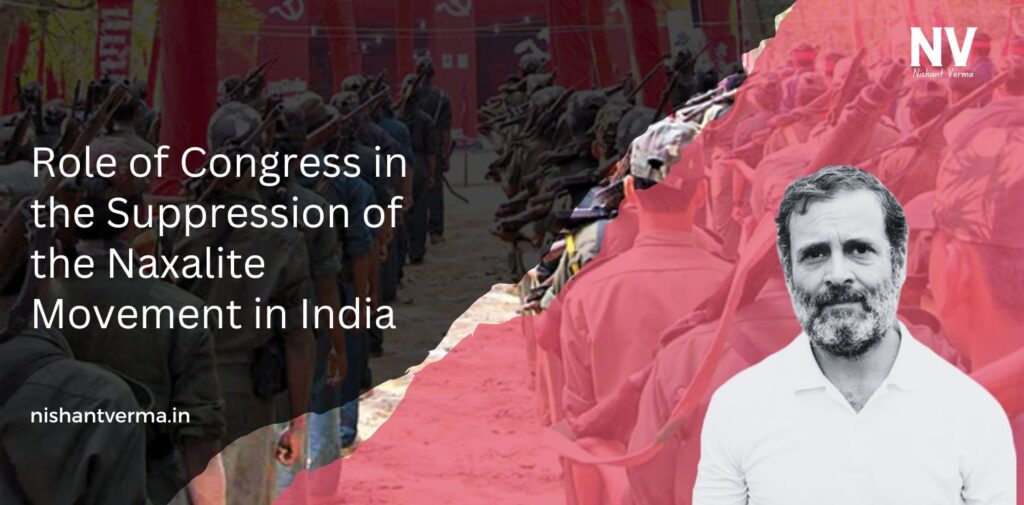The Naxalite movement, which began in the late 1960s, became one of the most significant socio-political movements in modern Indian history. It was born out of the frustration and anger of the marginalized, landless poor, and tribal communities who were being exploited by the traditional feudal system. The Congress Party, which had been in power since India’s independence in 1947, was directly involved in the suppression of the Naxalite movement. The party’s response to the movement was harsh, repressive, and, in many ways, failed to address the root causes of the Naxalite uprising.
The Naxalite movement was inspired by Maoist ideology and was founded by Charu Majumdar and Kanhai Chatterjee in Naxalbari, West Bengal, in 1967. Its primary aim was to overthrow the Indian state and replace it with a government that represented the rural poor, working class, and tribals. However, the response from the Congress-led government was one of brutal suppression, using police forces and military methods to crush the movement. Instead of engaging in dialogue or addressing the underlying issues that led to the movement, Congress chose to label it as a threat to national security and dealt with it through violence and repression.
This article aims to explore the role of the Congress Party in the suppression of the Naxalite movement, highlighting the failures, injustices, and lasting consequences of its actions.
The Origin of the Naxalite Movement
The Naxalite movement emerged as a response to several injustices that had plagued India for decades. Rural poverty, feudal exploitation, and the failure of the Indian state to deliver on promises of land reforms and social justice created the conditions for revolt. In many parts of India, landlords controlled vast tracts of land while peasants worked as bonded laborers, often living in extreme poverty.
The Congress Party, which had led the country since independence, had promised land reforms and social equality but failed to deliver. While some reforms were introduced, they were often watered down, poorly implemented, or blocked by powerful land-owning elites within Congress or its allies. This failure to address the root causes of inequality and injustice led to widespread discontent among the rural poor, especially in tribal and backward regions. The Naxalite movement, under the leadership of Majumdar, promised to bring about change through armed revolution.
The Naxalite ideology was inspired by Mao Zedong’s philosophy of peasant revolution, which saw rural areas as the key to overthrowing an oppressive government. The movement quickly spread to different states, including West Bengal, Andhra Pradesh, Odisha, and Bihar, where it found support among those who were angry at the economic exploitation and lack of opportunities.

Congress’ Brutal Suppression
The Congress-led government, under Prime Minister Indira Gandhi, viewed the Naxalite movement as a direct challenge to its authority and a threat to national unity. Instead of engaging with the movement’s grievances, the Congress Party chose to suppress it with force. The response to the Naxalite movement was swift, violent, and ruthless.
The government sent in paramilitary forces, the police, and even the military to crush the Naxalites. This led to widespread human rights abuses, including extrajudicial killings, torture, and the destruction of entire villages suspected of harboring Naxalites. The violence was not just directed at armed Naxalite rebels but also at innocent civilians who were caught in the crossfire. Thousands of people were arrested without trial, and many were killed under suspicious circumstances.
In many cases, the Naxalites were labeled as “terrorists” and treated as enemies of the state, with no attempt to address the legitimate grievances that fueled their rebellion. Rather than attempting to understand or engage in dialogue with the movement, the Congress Party treated it as a law-and-order issue. The violence escalated, creating a cycle of retaliation and further alienation of the rural population.
The Congress government not only relied on state violence but also encouraged vigilante groups to attack suspected Naxalite supporters. These groups, often local landlords or political goons with ties to the Congress Party, would engage in terror tactics against the rural poor, further escalating the crisis.

The Failure to Address the Root Causes
One of the biggest failures of the Congress Party in dealing with the Naxalite movement was its inability to understand the root causes of the rebellion. The Naxalites were not just fighting for an ideological cause; they were fighting against systemic issues of poverty, landlessness, and exploitation. The movement arose because the Congress Party failed to implement meaningful land reforms, address caste-based discrimination, or provide opportunities for the marginalized communities.
Instead of using its political power to bring about genuine socio-economic reforms, Congress chose to suppress the movement with military force. Had the government made efforts to address the issues of land reforms and social justice, it is likely that the Naxalite movement would have lost much of its support. However, Congress failed to do this, and its decision to use brute force only pushed more people toward the Naxalite cause.
For instance, the Land Ceiling Acts, which were supposed to redistribute land from large landowners to the landless poor, were poorly implemented or ignored. Powerful landowners, many of whom had close ties to Congress, found ways to bypass these laws. As a result, the rural poor remained landless, and the Naxalite movement gained traction as the voice of the oppressed.
Indira Gandhi’s Emergency Rule and the Naxalites
In 1975, Indira Gandhi declared a state of emergency across India, suspending civil liberties and allowing the government to rule by decree. During this period, the Congress government escalated its repression against the Naxalites. The emergency allowed for even more widespread arrests and detentions without trial. It was during this period that the state’s war against the Naxalites became even more brutal, with the government giving more powers to the police and military.
The Congress government’s authoritarian approach, especially during the emergency, pushed the Naxalite movement to new levels of militancy. The movement, which initially focused on rural issues, expanded into urban areas, and Naxalites became more radicalized, seeing the state as an enemy that must be overthrown by force. Congress, instead of trying to heal the wounds caused by its repressive actions, doubled down on its stance of using military force to crush the movement.

Long-term Consequences of Congress’ Actions
The Congress Party’s response to the Naxalite movement did not solve the problems at the root of the uprising. In fact, the harsh tactics employed only worsened the situation. The use of violence and repression created an environment of fear and resentment, particularly in the tribal and rural areas where the Naxalites had their roots.
The Congress Party failed to recognize that violence and repression could not solve the issues of poverty, inequality, and social injustice. By treating the Naxalite movement as a simple law-and-order problem, the Congress government ignored the underlying socio-economic problems that were driving the unrest. As a result, the Naxalite movement continued to grow, and over time, it spread to new areas, becoming a long-lasting insurgency.
Even after decades, the Naxalite movement continues to pose a challenge to India’s security, and the Congress Party’s role in fostering this insurgency cannot be ignored. Had the Congress government taken a more inclusive, compassionate approach to the issues of the rural poor, rather than resorting to violent repression, India’s political landscape might have been very different today.
Conclusion
The Congress Party’s role in the suppression of the Naxalite movement was one of neglect, violence, and missed opportunities. Instead of addressing the deep-rooted issues of inequality, landlessness, and exploitation that fueled the Naxalite uprising, Congress chose to crush the movement through violence and repression. The failure to engage in dialogue, implement meaningful reforms, and address the grievances of the poor led to the long-lasting insurgency that continues to haunt India’s rural areas.
The Congress Party’s inability to understand the true causes of the Naxalite movement and its choice to use force rather than reforms is one of the darkest chapters in India’s post-independence history. By focusing on suppressing dissent rather than addressing the underlying social and economic problems, Congress only ensured that the Naxalite movement would continue for generations to come.




